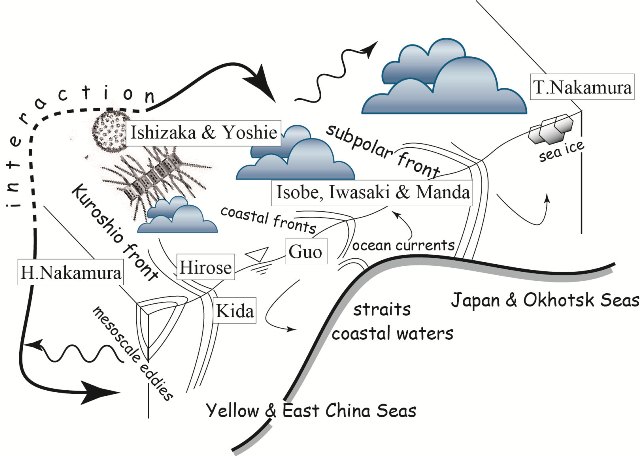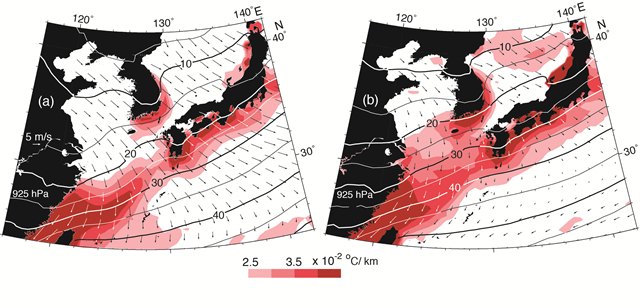Air-sea interactions with complex oceanographic structure over the marginal seas and their influence on marine ecosystem
| A01-1. Air-sea interactions with complex oceanographic structure over the marginal seas and their influence on marine ecosystem | |
|---|---|
| PI | Atsuhiko ISOBE* (Prof., Kyushu Univ.) |
| Members | Joji ISHIZAKA* (Prof., Nagoya Univ.), Xinyu GUO* (Assoc. Prof., Ehime Univ.), Hirohiko NAKAMURA* (Assoc. Prof., Kagoshima Univ.), Naoki HIROSE* (Assoc. Prof., Kyushu Univ.), Shin'ichiro KIDA* (Researcher, JAMSTEC), Shin'ichiro Kako* (Res. Assoc., Kagoshima Univ.) |
| Adjunct members | Tomohiro NAKAMURA* (Assist Prof., Hokkaido Univ.), Atsuyoshi MANDA* (Assoc. Prof., Nagasaki Univ.) |
| PD | Shinsuke IWASAKI* (Kyushu Univ.) |
JAMSTEC: Japan Agency for Marine-Earth Science and Technology
[Doctral degree: *Oceanography]
Over the East Asian marginal seas including the Sea of Okhotsk, we are able to find complex ocean processes such as oceanic fronts associated with Kuroshio and Tsushima Currents, sub-mesoscale eddies of which horizontal scales are less than 100 km, and sea ice production. Our research objectives are to investigate how atmospheric processes with the synoptic/mesoscale scales (say, development of extratropical cyclones) are influenced by these ocean processes with relatively smaller spatial scales. In addition, our focuses are placed on whether the atmospheric processes altered above marginal seas again influence marginal seas. Do atmosphere-ocean coupled processes actually occur even in relatively narrow marginal seas?
Our challenge is to uncover the coupled processes which have been received little attention in extratropical marginal seas, using analyses of archived observed/satellite data along with regional modelings of ocean, atmosphere, ecosystem, and their coupled one. Itemized below are on-going studies by A01-1 members.
- (i) Responses of storm tracks to bimodal Kuroshio path states south of Japan. (H. Nakamura, submitted to J. Climate)
- (ii) Prediction of the regional snowfall along Japan Sea coasts by monitoring commercial ferryboat data across the Tsushima/Korea Strait (N. Hirose)
- (iii) Development of an ocean-reanalysis product available for East Asian marginal seas (DREMAS project [http://dreams-i.riam.kyushu-u.ac.jp/vwp/], N. Hirose)
- (iv) Numerical and observational studies on atmospheric responses to tidal fronts in the Seto Inland Sea (X. Guo)
- (v) Numerical studies on interactive processes among lower-level atmosphere, ocean, and sea ice (cooperative research with T. Nakamura, A03-9)
- (vi) Numerical and observational studies on roles of East Asian marginal seas in the development of extratropical cyclones (A. Isobe; cooperative research with A. Manda, A01-2; S. Iwasaki)
- (vii) Theoretical studies on throughflow dynamics over the East Asian marginal seas (S. Kida)
- (viii) Interaction among atmosphere, ocean, and primary production over the East Asian marginal seas. (J. Ishizaka; cooperative research with N. Yoshie, a member of supplementary program)

Fig.1 Overview of program # A01-1
One of our research outcomes to date is highlighted below (Isobe & Kako, “A role of the Yellow and East China Seas in the development of extratropical cyclones in winter”, J. Climate, in press)
To investigate whether the relatively warm Yellow and East China Seas play an active role in the deepening of extratropical cyclones over East Asia during winter, a regional numerical atmospheric model is adopted to find atmospheric and/or oceanic conditions favorable for development of extratropical cyclones over the study area. The modeled lower-level vorticity fields demonstrate that, on average, extratropical cyclone activity is moderate over the warm Yellow and East China Seas. This is because enhanced lower-level baroclinicity (deduced by the horizontal gradient of equivalent potential temperature at 925 hPa) over these ocean areas is transferred as far as the shelf beak of the East China Sea by strong northwesterly surface winds (Fig. 2a). Based on the numerical model results, the weak northwesterly surface wind condition is required for enhancing lower-level baroclinicity over the Yellow and East China Seas (Fig. 2b). This baroclinicity may contribute to enhancing cyclone development near Japan, with simultaneous increase of lower-level baroclinicity over the Sea of Japan.

Fig. 2: Horizontal distribution of modeled equivalent potential temperature (EPT) at 925-hPa height (solid curves) along with its horizontal gradient depicted by shading in the strong-wind (a), and weak-wind (b) phases over the Yellow and East China Seas. Contour interval of EPT is 5°C, and scale of shading is at lower portion. Also shown are wind vectors at every tenth grid in each phase.

